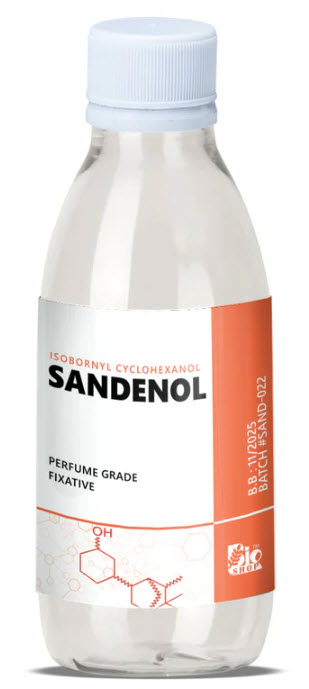Sandenol is a synthetic aroma chemical widely used in perfumery for its fresh, woody, and sandalwood-like scent. It is a key component in creating sandalwood accords, which are highly prized in perfumery for their creamy, warm, and luxurious qualities. Below is a detailed explanation of Sandenol, including its properties, uses, and significance in perfumery.

1. Chemical Structure and Properties
- Chemical Name: Sandenol
- IUPAC Name: (Z)-2-(2,4-Dimethylcyclohex-3-en-1-yl)propan-1-ol
- Molecular Formula: C₁₁H₂₀O
- Molecular Weight: 168.28 g/mol
- Appearance: A colorless to pale yellow liquid.
- Odor: Fresh, woody, creamy, and sandalwood-like with a slightly milky and balsamic undertone.
- Solubility: Insoluble in water but soluble in alcohol and oils, making it suitable for use in perfumes and cosmetic formulations.
- Boiling Point: Approximately 250°C (482°F).
- Stability: Stable under normal conditions but can degrade under strong acids, bases, or UV light.
2. Role in Perfumery
Sandenol is a versatile fragrance ingredient with several key roles:
- Sandalwood Accord: It is a key component in creating sandalwood accords, which mimic the scent of natural sandalwood oil.
- Blending Agent: It harmonizes well with other woody, creamy, and balsamic notes, creating a balanced and luxurious scent profile.
- Base Note: It is often used as a base note in perfumes, providing a long-lasting, warm, and woody foundation.
- Fixative: It helps stabilize and prolong the scent of a perfume by slowing down the evaporation of more volatile components.
3. Fragrance Profile
Sandenol contributes the following olfactory characteristics to a perfume:
- Woody: Adds a smooth, creamy, and sandalwood-like warmth.
- Creamy: Imparts a milky, soft, and luxurious quality.
- Balsamic: Provides a rich, resinous, and slightly sweet undertone.
- Fresh: Creates a bright, uplifting, and slightly green effect, enhancing the overall diffusion of the fragrance.
4. Common Uses in Perfumes
Sandenol is a staple in many fragrance families, including:
- Woody Fragrances: It is a key component in woody perfumes, particularly those featuring sandalwood, cedarwood, and vetiver.
- Oriental Fragrances: Its warm and creamy qualities make it ideal for oriental and amber compositions.
- Floral Fragrances: It enhances the richness and depth of floral accords, particularly in white floral and powdery compositions.
- Modern Fragrances: Its unique and multifaceted scent profile makes it popular in avant-garde and niche perfumery.
5. Safety and Regulation
Sandenol is generally considered safe for use in cosmetics and fragrances when used within recommended concentrations. Key points include:
- IFRA Compliance: The International Fragrance Association (IFRA) sets guidelines for the maximum allowable concentration of Sandenol in different product types to ensure safety.
- Allergen Potential: It is not classified as a significant allergen, but it is always recommended to conduct patch tests to ensure it does not cause adverse reactions in sensitive individuals.
6. Advantages in Perfumery
- Versatility: It blends well with a wide range of fragrance materials, including woods, florals, and ambers.
- Longevity: Its fixative properties help prolong the lifespan of a perfume on the skin.
- Luxurious Appeal: Its creamy and sandalwood-like qualities make it ideal for creating luxurious and high-end fragrances.
- Cost-Effectiveness: As a synthetic ingredient, it is more affordable than natural sandalwood oil, which is rare and expensive.
7. Limitations
- Overuse: Due to its popularity, it can be overused in some fragrances, leading to a generic or “synthetic” smell.
- Regulatory Restrictions: Compliance with IFRA and EU regulations may restrict its use in certain formulations.
8. Example Perfumes Featuring Sandenol
Sandenol is found in numerous iconic fragrances, including:
- Tam Dao by Diptyque: Enhances the woody and creamy sandalwood accords.
- Santal 33 by Le Labo: Complements the sandalwood and musky notes.
- Egoiste by Chanel: Adds warmth and richness to the woody and oriental composition.
9. Conclusion
Sandenol is a fundamental aroma chemical in modern perfumery, prized for its creamy, woody, and sandalwood-like characteristics. Its ability to act as a base note, fixative, and blending agent makes it indispensable in creating warm, luxurious, and long-lasting fragrances. While it is generally safe, its potential for overuse necessitates careful formulation and adherence to regulatory guidelines. Its versatility and unique scent profile ensure its continued prominence in the fragrance industry.